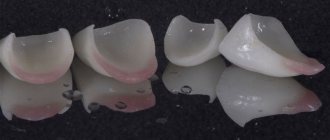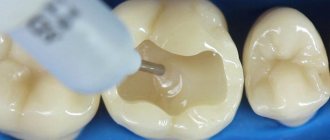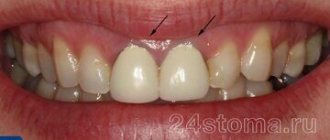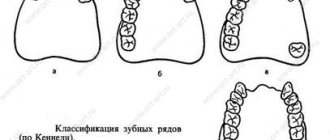Metal fillings
Filling teeth with amalgam
Amalgam is a medical metal containing tin, zinc, mercury and silver. Most often, this filling is placed on the distant chewing teeth. Modern dentists use copper and silver amalgams, where these metals predominate.
The advantages of amalgam-based fillings are as follows:
- Long service life, which can reach 15 years or more;
- Strength;
- Low price;
- Plastic;
- The possibility of preserving tooth color appears if fillings from the latest generations of amalgam are used;
- Easy to install;
- Tight edge seal.
Disadvantages of using amalgam for filling teeth:
- Low aesthetics: the filling will stand out noticeably against the background of the tooth;
- Long curing time;
- The release of mercury vapor, which most likely affects not the patient himself (it has been proven that even when wearing 10 amalgam fillings, the body will not receive mercury exceeding the maximum permissible concentrations), but rather the employees of the dental office;
- It is impossible to install a gold crown, since the amalgam filling will be destroyed;
- Shrinkage of the filling;
- Increased thermal conductivity.
Gold alloy for filling teeth
Fillings made from metals, including their precious analogues, are not popular in modern dentistry, as they are too noticeable on the teeth. While most patients strive for maximum naturalness and naturalness. However, those who decide to install such a filling should know about its advantages and disadvantages.
Advantages of gold alloy fillings:
- Long service life;
- Increased strength.
Disadvantages of gold alloy fillings:
- High price for a filling;
- Impossibility of installation with amalgam fillings.
Types of dental filling materials
The tooth is filled at the final stage in curing teeth from carious plaque and possible problems after it. The filling helps restore the drilled part of the tooth and returns it to its original appearance. If the filling material is chosen correctly, it will last a long time and will not cause any complaints. If the doctor did his job “carelessly”, without individually selecting the material for filling the tooth for the patient, then even the most expensive and high-quality filling may fall out the next day.
To avoid such a situation, it is not necessary to look through a bunch of material on the topic of dental fillings on the Internet, or ask a lot of friends which dentist they treated their teeth with. In order to know what filling materials exist, and which of them are used most often in dentistry, read our article, we will tell you all the nuances of this process. We hope that after reading, you will have a better understanding of the topic and you will not have any questions about it.
Types of materials for fillings
Materials for fillings are classified according to the content of components, features and method of use.
Initially, they were divided into three groups - temporary and permanent fillings and gaskets.
Material for temporary filling
Fillings that are installed for a short period of time are not very strong and not particularly aesthetically pleasing. But these features are not important, because they are installed for only a couple of weeks and do not bring much discomfort to the wearer. But since temporary filling is most often installed while a tooth or gum is healing, it has a high cost. During dental therapy, temporary material also promotes faster healing. Popular temporary fillings are Septopak, Parasept, Tempofot, Koltosol and others.
Treatment pads
Therapeutic pads are used to promote rapid tooth healing. The hydroxide contained in this product prevents tissue inflammation and prevents the transformation of caries into pulpitis. The pads are applied to the bottom of the drilled and cleaned tooth, the top is covered with a separating pad, and then a permanent compound is installed on the tooth. Dentists prefer Deykal, Life, Calcipulp, Pulpomixin and others for their work.
Insulating gaskets
Having touched upon the topic of insulating gaskets above, we also note their beneficial properties. Since fillings are a foreign object, they can irritate the dental pulp. To reduce the likelihood of this action, it is necessary to use insulating gaskets. Before their invention, the pulp was isolated with a phosphate cementitious dental solution. But based on their experience of using it, dentists noticed that this material does not cope with its task very well. Glass polymer insulating gaskets “Copalight”, “Whitebond”, “BaseLine” and others are produced.
Permanent fillings
There are a great variety of materials for conventional dental fillings. All this diversity can be divided into three general classes:
- cements;
- amalgams;
- composites.
Each of these groups is also divided into subgroups, depending on their own individual characteristics.
Cements for fillings
These groups include silicate, polycarboxylate, phosphate and glass ionomer cements. But in today's medicine, these components are used to secure stable dentures. Filling with cements has faded into the background.
Amalgams for permanent fillings
This type of raw material is a durable alloy of metals and mercury. Its use in dentistry has a long history of more than 100 years. Today, silver amalgam with a large amount of copper admixture is used. But amalgams also have their disadvantages - they do not adhere well to the teeth and are a conductor of heat. And the presence of mercury (a radiation and poisonous metal) in the composition is considered a controversial point in the decision to install this particular material.
Composites for fillings
This material is considered one of the most widely used. A composite filling is easy to apply, holds well, and meets beauty requirements. Composites for permanent fillings consist of a combination of only two chemical components. Hardening occurs after the filling is placed on the tooth, as a result of the interaction of the material with air. This is also affected by the main component of the material. Depending on this, it can harden not only due to a reaction to air, but also after complete installation, as a reaction to the light of a special lamp.
When preparing a solution, the dentist mixes a small amount of a catalyst into chemical composite materials, which affects the hardening of the components. If the doctor works for too long, the material may dry out before the work is completed. That is, the dentist must have time to mix the components and catalyst, simulate a model of the drilled tooth for the aesthetic appearance and convenience of the patient, before the composite begins to harden. Otherwise, the work will have to be done again. The disadvantages of a chemical composite also include a small selection of color shades that could be matched to the color of the patient’s teeth.
Light-hardening filling composites are most often used in dental clinics. They are easy to use and aesthetically pleasing. And the dentist can control the hardening of the material independently, after the complete process of modeling the tooth to be filled. This control is carried out using an ultraviolet lamp. For high-quality work, the dentist is provided with a wide selection of shades of this type of composite composition. The doctor can calmly select the shade of the material so that it does not differ in color from the natural teeth, and form a filling for restoration. At the moment, doctors have not found any downsides to this product, but note only its positive aspects - long-term stability, beauty, a large palette of shades. Stability is determined by high-quality fixation of the filling composition with the inside of the tooth and insulating materials.
Take care of your teeth, treat them on time and be healthy!
Non-metallic fillings
Cements for filling teeth
Cements are widely used for the manufacture of a wide variety of fillings. They are included in permanent fillings in adults, these materials are used to fill baby teeth in children, and cements are used to make insulating linings.
- Phosphate cements cannot act as an independent material for making fillings, since they tend to decrease in volume after installation. Therefore, to prevent gaps from appearing between the tooth and the filling, and to avoid a loose fit of the filling, zinc phosphate cements are used only as a spacer when installing other fillings, and they are also used to fix crowns.
- Silicate cement is used to fill a tooth after a layer of phosphate cement has been installed on the pulp. The fact is that silicate material is not able to independently provide the necessary permeability, and it can have a pathogenic effect on the pulp. In addition, this cement will dissolve under the influence of saliva and has toxic properties, which is why modern dental clinics do not use silicate cement.
- Combined silicate-phosphate cement has absorbed all the best qualities of the two previous cements. It does not stick to the walls of the dental cavity, while it is as hard as silicate cement and has the necessary transparency. Another advantage of this cement filling is that it does not conduct heat. The disadvantages of fillings made from silico-phosphate cements are: not very high aesthetic qualities, low strength and poor resistance to the environment in the oral cavity, as well as toxicity to the pulp, and therefore it is necessary to use an insulating lining. It is these fillings that are most often installed in free dental offices, as they are low in cost.
- Glass ionomer cement is another modern cement that is characterized by increased strength and durability. This cement adheres well to the tooth and is not toxic. In addition, in the process of wearing such a filling, fluoride is released from it, which contributes to additional protection of the tooth from carious destruction. However, this modern material also has disadvantages. It is fragile and, like all other cements, has increased abrasion. In this regard, glass ionomer cement is used as insulating linings and for securing dental inlays.
Plastic fillings
In dentistry, plastic is used as a material for making temporary fillings.
Their advantages:
- High hardening speed;
- Resistance to chemical agents;
- No oral irritation.
There are many more disadvantages of plastic fillings than positive qualities:
- Reducing the volume of the filling during operation;
- Subsidence of the filling;
- Quick change of original color;
- Tooth destruction as a result of deformation of the filling.
Plastic fillings include acrylic oxide and carbondent.
Acrylic plastics are produced by a domestic manufacturer and have the following advantages:
- High adhesion (adhesion to tooth tissue);
- Tight fit to the walls of the cavity, negligible shrinkage;
- Easy to dispense powder and liquid;
- Resistance to external irritants;
- Long-term preservation of the original color.
However, despite the strength of acrylic oxide, it is chemically toxic and will eventually lead to the development of an inflammatory reaction under the filling.
Compared to acrylic oxide, carbondent is denser, less toxic, but very fragile and quickly darkens.
Ceramic fillings
Ceramic fillings have a number of advantages, including:
- Increased hardness;
- Resistance to original color;
- Maintaining the original size, no shrinkage;
- Excellent aesthetic qualities.
Ceramic fillings are made as an inlay, that is, according to a pre-made impression of a treated tooth. The configuration of the ceramic filling makes it possible to evenly distribute the load throughout the entire tooth during the process of chewing food. There are several types of ceramic fillings: from pressed ceramics, from metal ceramics, with zirconium oxide included in their composition. One and perhaps the most significant disadvantage of a ceramic inlay is its high cost compared to fillings made of other materials.
Light-curing composite fillings
Light-curing fillings are those that harden as a result of exposure to light of a certain frequency. They are as close as possible to the appearance of a person’s own teeth, almost invisible after their installation, durable and initially look perfect. The advantage of these materials is that they are highly polishable, and their high aesthetic qualities make it possible to use these fillings for the treatment of anterior teeth. However, over time, such fillings need to be replaced, as they will still shrink.
Cements
Cement fillings come in several types, depending on the composition of the material:
- silicate;
- silicophosphate;
- phosphate;
- glass ionomer.
The first three groups are rather fragile cements, low resistance to abrasion and characterized by not very reliable fixation in the carious cavity. They were installed everywhere in the past, but today such materials are considered obsolete and are used extremely rarely. It is advisable to use them only in the treatment of primary teeth, when special durability of the restoration is not required, but ease of installation and low cost are important.
Glass ionomer cements are a new generation of filling agents, since in this case the tooth filling contains components that can release fluoride and thereby prevent the development of secondary caries. This cement has a high chemical affinity for natural dental tissues and good marginal adhesion. However, glass ionomers have not completely eliminated all the disadvantages of cements, such as low strength, which is why they are also recommended for use mainly in pediatric dentistry. Such fillings are also suitable for treating children because they are relatively inexpensive and can be given different color shades - and colored fillings have become especially popular lately.
Materials for filling root canals of teeth
Root canals are filled when caries reaches the stage of pulpitis. The essence of filling is to fill the tooth canal as tightly as possible with the selected material. Modern dentistry makes this process painless and quick.
The following materials are used for this:
- Gutta-percha is the result of processing a material such as latex. When heated, gutta-percha becomes viscous, and after cooling it hardens. This material has high biological compatibility with dental tissues, has low toxicity, does not dissolve, and does not cause allergic reactions. If such a need arises, gutta-percha can be removed from the dental canal. The disadvantages of the material include the lack of bactericidal properties, the inability of the material to adhere to dentin, and the difficulty of installation.
- Silver pins are used less and less in modern dentistry, as it has been found that they tend to oxidize and provoke a relapse of inflammation.
- Titanium pins do not provoke allergic reactions, are very durable, light in weight and do not corrode. However, they can only be used if the tooth is slightly damaged and there is no nerve in the canal.
- Natural pastes (sealers) contain various antiseptic and antibacterial components that prevent the development of inflammation, they do not cause difficulties in installation and dissolve over a long time. The disadvantages of sealers include the likelihood of developing an allergic reaction and the presence of toxic components. In addition, upon contact with the mucous membrane, they can cause throbbing pain.
- Polymer pastes (sealers) are used more often than natural ones, since they do not stain the tooth, do not dissolve in liquids, and have good attachment to the canal walls. However, they can provoke an allergic reaction, especially for patients prone to such manifestations.
- Cortismol is a powder that helps eliminate pain after it is introduced into the root canal of a tooth, as it contains hormones. However, it cannot be used to fill the front teeth, as it contains coloring pigments.
- Kanason Combipak acts as an antiseptic and antibacterial agent for filling. It isolates the channel perfectly, but the main disadvantage of using it is the long installation time.
- Glass ionomer cement is not suitable for filling dental canals, as it has low strength and allows fluid to pass through. Therefore, it is often used for filling baby teeth.
- Polymethylsiloxane has an excellent ability to fill even the smallest cavities, as it consists of tiny particles. Its main disadvantage is the novelty of the material and insufficient knowledge of its effect on the body.
- Cements are used to fill tooth canals only after applying isolation.
Metals
Metal filling materials belong to the class of amalgams - alloys of various metals with mercury. Usually, upon learning that a dental filling contains mercury, the patient begins to fear its toxic effects. In fact, although there are many publications about the dangers of amalgams, the harm from them is much less than, for example, from smoking - a smoker receives more mercury from cigarette smoke than can, in principle, be released from a filling.
These are extremely strong and durable filling bases that can last for decades. Their main disadvantages are their unaesthetic appearance (they can only be installed on chewing teeth, which are not visible to others), a long curing period (2-3 hours) and difficulties in installation. The difficulty of installation lies in the fact that when hardening the material slightly increases in volume and, if the dentist does not calculate correctly, it can break the tooth wall.
Usually, when choosing, the patient pays special attention to cost. In fact, it is necessary to take into account both the service life and the “behavior” of the material in the mouth. After all, if you install a cement restoration and then change it every year, in the end the treatment will cost much more than installing a photopolymer.
Modern methods of filling tooth canals
- The depophoresis method allows you to sterilize the canals, filling all existing cracks and cavities. Depophoresis allows you to cure even the most difficult cases, for example, when the tooth canals are crooked or access to them is difficult. Using a special instrument, a medicinal substance (calcium and copper hydroxide) is injected into the canal, achieving complete sterilization.
- Filling teeth using thermophile obturation using heated gutta-percha. This is a simple and reliable way to fill canals, but an unpleasant consequence can be the filling material leaking beyond the boundaries of the canal.
Heated gutta-percha can be used for filling using the following methods:- Injection method, when gutta-percha is applied to the problem area, the temperature of which reaches 100 °C (only a highly qualified dentist can perform the procedure);
The vertical condensation method allows for three-dimensional canal filling, but is very difficult to implement;
- The continuous wave method is similar to the vertical condensation method, but is not as long in time;
- Syringe injection is a quick and convenient method of filling the canal, but it will not be able to reach the lateral tubules.
- Method of filling canals using cold gutta-percha.
- Single pin method (a gutta-percha pin is made according to the shape of the canal);
- The lateral condensation method (several gutta-percha pins are used to fill the canal), in this case there is a risk of fracture of the tooth root and loose filling of its canal;
- The thermomechanical condensation method (the canal is filled using a rotating instrument), in this case there is a risk of instrument fracture and poor-quality filling of the dental canal.
- Mummification of the canal. In this case, the pulp is treated with a large number of antiseptics, which stops the progression of the inflammatory process.
- Retrograde dental filling is a modern method of root canal filling. To perform the procedure, a special nozzle and a gun are used to perform the injection. First, the root is filled with the selected material using a retrograde movement, and then the doctor can move on to vertical filling.
Previously, canal filling was used using a resorcinol-formalin mixture, but this method has many side effects, and modern dentists have abandoned it.







